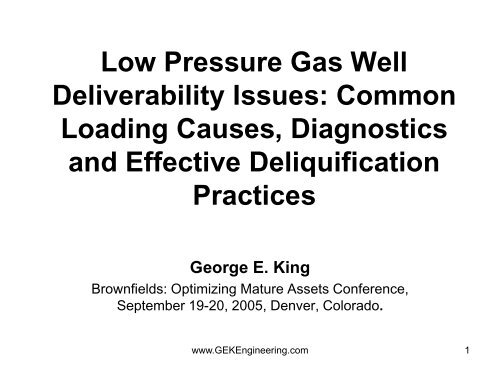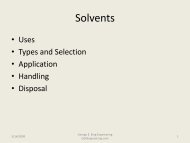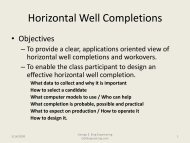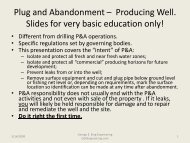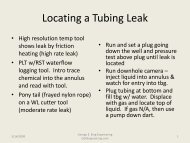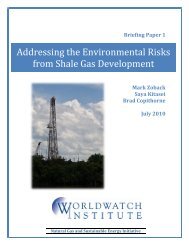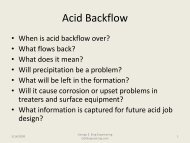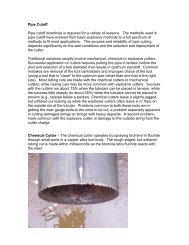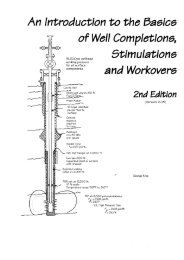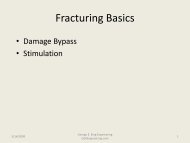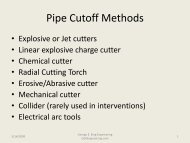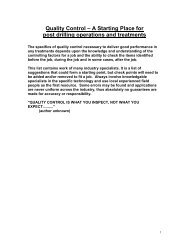Deliquification - George E King Petroleum Engineering Oil and Gas ...
Deliquification - George E King Petroleum Engineering Oil and Gas ...
Deliquification - George E King Petroleum Engineering Oil and Gas ...
Create successful ePaper yourself
Turn your PDF publications into a flip-book with our unique Google optimized e-Paper software.
Low Pressure <strong>Gas</strong> WellDeliverability Issues: CommonLoading Causes, Diagnostics<strong>and</strong> Effective <strong>Deliquification</strong>Practices<strong>George</strong> E. <strong>King</strong>Brownfields: Optimizing Mature Assets Conference,September 19-20, 2005, Denver, Colorado.www.GEK<strong>Engineering</strong>.com 1
Technology -What Technology Will Drive <strong>Deliquification</strong>?Cost, price?Life Cycle of a <strong>Gas</strong> WellMay Add Energyto SystemWhat’s New?www.GEK<strong>Engineering</strong>.com 2
US Mature Well Base (2001)• 880,000 producing or temporarilyab<strong>and</strong>oned wells• 320,000 gas wells (many at 5 to 15 mcf/d)• Vast majority of these wells are lowpressure <strong>and</strong> low rate.www.GEK<strong>Engineering</strong>.com 3
<strong>Gas</strong> Wells: Two Facts• Potential: Very long life in some cases –30 to over 70 years <strong>and</strong> large recovery forevery extra 10 psi drawdown.• Challenge: Liquid loading from condensedor connate fluids will kill or sharply reducethe production.www.GEK<strong>Engineering</strong>.com 4
Tubing Performance - Vertical<strong>Oil</strong> WellP<strong>Gas</strong> WellPgas, oil<strong>and</strong> waterWater vaporcondenses asgas rises <strong>and</strong>exp<strong>and</strong>s.gas <strong>and</strong>liquidDToil, water<strong>and</strong> gasWater must beremoved toallow the well toflow.oilWater thatbuilds up holdsa backpressureon theformation.gaswww.GEK<strong>Engineering</strong>.com 6
<strong>Gas</strong> Rate (mscf/d)300025002000Turner Unloading Rate, WaterFor pressures > 1000 psi4.5" (3.958" ID)3.5" (2.992" ID)2.875" (2.441" ID)2.375" (1.995" ID)2.0675" (1.751" ID)1500100050000 100 200 300 400 500Flowing Pressure, psiwww.GEK<strong>Engineering</strong>.com 7Source – J. Lea, Texas Tech, Turner Correlations.
Minimum Critical Velocities• Turner <strong>and</strong> Coleman Equations• Estimate minimum gas flow velocityneeded to lift water droplets out of well.• If flow velocity below critical, then waterdroplets fall / build up in bottom of well.• The well may or may not cease to flowbut production will be decreased.www.GEK<strong>Engineering</strong>.com 8
<strong>Gas</strong> Flow Rate, MSCFDSmall <strong>Gas</strong> Well Example – LiftProgression – 2-3/8” TubingFlow <strong>and</strong> Lift - 2-3/8" Tubing2000180016001400120010008006004002000Flow to herethen plunger0 20 40 60 80 100Percent of Well Lifethen ?www.GEK<strong>Engineering</strong>.com 9Source -BryanDotson
Pump HPWe’ll have to put energy intothe well:Pump Power(assumes 50% Efficiency <strong>and</strong> 200 psid friction drop)98765432101000' depth5000' depth10000' depthLow Pow er is 1-10 HP.Micro Pow er is less than2 HP.1 5 10 25 50 100 150 200BPD of Waterwww.GEK<strong>Engineering</strong>.com 10
How Much Can We Pay?$300,000$250,000$200,000$150,000$100,000$50,000$0$15,00010If plungers get us to 50MSCFD, we can’t affordtoo much..$70,00050Incremental MSCFD$140,000100$280,000200www.GEK<strong>Engineering</strong>.com 11
System Requirements• Low initial cost.• Reasonable life: 3-5 years; more is better.• Low cost energy.• H<strong>and</strong>le gas gracefully.• Automatic pump-off control.• 180F to 280F, to 12000 feet.• H<strong>and</strong>le solids <strong>and</strong> paraffin well.• Resistant to CO2 <strong>and</strong> H2S corrosion.• Works in highly deviated wells.• Acid-resistant.• Resistant to scale formation.www.GEK<strong>Engineering</strong>.com 12
MonoboreHighPackerLiner <strong>and</strong>& GapLongMonobore& Tail PipeSmall TailPipeTaperedString <strong>and</strong>RestrictionsThe designof the wellbore canalter thevelocity.V 6V 5V 4Where iscritical ratecalculated?V 1+V 3Multiplevelocitycalculationsare neededwith gas incompressedstate.V 2V 2V 1V 1V 3V 1V 3 V 1V 2V 2www.GEK<strong>Engineering</strong>.com 13
<strong>Gas</strong> Bubble Growth With RiseIn A Water Column292 cm 3surface14.7 psi (1 bar)2 cm 35000 ft 2150 psi (146 bar)(1524m)1 cm 310000 ft 4300 psi (292 bar)(3049m)<strong>Gas</strong> column is different – gas is low density at the top of a52887040.pptcolumn <strong>and</strong> higher density at bottom – so although rate isconstant, velocity is not.www.GEK<strong>Engineering</strong>.com 14
Liquids in <strong>Gas</strong> Wells• <strong>Gas</strong> phase – condensing to a liquid– Water – several bbls/mmcf, unusually fresh– Condensate – can be much higher volume• Connate Water– Usually saltier than condensing water– Often stays in bottom of the well.www.GEK<strong>Engineering</strong>.com 15
Where is Critical Rate Calculated?Surface or Bottom Hole?Pres: 400#Temp: 60 deg FTbg: 1 ¼” CTRate: 200 mscfdWellheadCritical Rate:180 mscfd10,000’ 1 ¼” CTPres: 900#Temp: 200 deg FBottom of TubingCritical Rate: 220 mscfd10,500’ 3 ½” Csg to PerfsPres: 1100#Temp: 200 deg FCasingCritical Rate:1500 mscfdwww.GEK<strong>Engineering</strong>.com 16
STB/MMscfWater Content of Wet <strong>Gas</strong>Pressure10000.001000.00100.0010.0014.7100200500100020003000400050001.000.100.0150 100 150 200 250 300 350Temperature (deg F)www.GEK<strong>Engineering</strong>.com 17How much potential water condensation are we facing?
Condensation Drivers• Loss of temperature– <strong>Gas</strong> condenses to liquid phase• Loss of Rate– Slower velocity =>• Poorer lift potential.• Longer transit times, more heat loss, morecondensation opportunity.– Less flowing mass => less total heat to loosebefore water starts to condense.www.GEK<strong>Engineering</strong>.com 18
Diagnostics: The production history of a well starting to loadup. There are usually many causes that lead to load-up.www.GEK<strong>Engineering</strong>.com 19
4/25/20005/2/20005/9/20005/16/20005/23/20005/30/20006/6/20006/13/20006/20/20006/27/20007/4/20007/11/20007/18/20007/25/20008/1/20008/8/20008/15/20008/22/20008/29/20009/5/20009/12/20009/19/20009/26/200010/3/200010/10/200010/17/200010/24/200010/31/2000Typical Wamsutter New Well Decline3500Champlin 242-C33-1/2” Production Casing300025002000150010005000<strong>Gas</strong> Rate (MCF/D)Line Pressure (PSI)www.GEK<strong>Engineering</strong>.com 20
Note pressuresLiquidholdupfromdecliningvelocityThe liquidholdupapplies abackpressure to thebottomhole.Rate isdecreasedEnoughliquidfinallydropsdown thewell toreduce orbalanceformationpressure.Flow isdecreasedor the wellis dead.www.GEK<strong>Engineering</strong>.com 21
An increase inthe differentialbetween casing<strong>and</strong> tubingpressure overtime indicatesloading.No packerexample.Csg-tbgpressureTimewww.GEK<strong>Engineering</strong>.com 22
Gradient survey to locate static liquid level.www.GEK<strong>Engineering</strong>.com 23
Lift Selection Considerations• Size of the prize?• Cost of water prod?• How much water?• Source?– Water control?• Condensation cause?• Condense location?• Well limits?• Safety valve?• Power?• Computer control?• Well W/O costs?• Well W/O risks?www.GEK<strong>Engineering</strong>.com 24
Lift <strong>and</strong> <strong>Deliquification</strong>• Natural Flow• Intermitter• Rocking• Equalizing• Venting• Soaping• Velocity String• Compression• <strong>Gas</strong> Lift• Beam Lift• Plunger• ESP <strong>and</strong> HSP• PCP• Diaphragm Pump• Jet Pump• Eductorwww.GEK<strong>Engineering</strong>.com 25
What causesthe sharpinitial declinewhen thewell isbrought on?QWhat causes the short-lived increasesin rate when a well is started up after abrief shut-in?Can it be used foradvantage?www.GEK<strong>Engineering</strong>.com 26Cumulative Production
Why the increase after a shut-in?1. Recharging of the near wellbore from theformation away from the wellbore.2. Cross flow from low permeability, higherpressure zones to high permeability,partly depleted zones (also recharging).– High perm streaks– Natural fractures– Stimulated fractureswww.GEK<strong>Engineering</strong>.com 27
Shutting in a Well at Surface Doesn’t Mean the Flow Stops Downhole!Most formations arelayered <strong>and</strong> often havedistinctly differentpermeabilities in apackage of pay.These layers flow asindividual units,emptying the higherperm units first beforethe lower permreservoirs begin to flow.When a well is shut in,higher remainingpressures in the lowperm layers cause flowinto the high perm, moredepleted streaks.Natural cross flow!fracturedFractured, high permshaleshale10 md10 md1 md 1 mdshaleshale10 md 10 mdwww.GEK<strong>Engineering</strong>.com 28
Using Cross Flow• Repressuring the higher permeability streaksduring a shut-in can lend a sharp, short livedincrease to flow <strong>and</strong> can help unload a wellwithout outside equipment or services.• To use it effectively, the behavior of the wellsuch as how quickly it recharges, how quickly itblows down <strong>and</strong> what happens to the waterduring a shut-in must be understood.www.GEK<strong>Engineering</strong>.com 29
Lift <strong>and</strong> Unloading Options• At least 15 options of full time <strong>and</strong> parttime lift.• The well design, conditions <strong>and</strong>economics dictate the optimum method –<strong>and</strong> remember – both can change withdecline.• Another very important contributor is theoperator.www.GEK<strong>Engineering</strong>.com 30
Well With A Plunger InstallationInstalled Plungerwww.GEK<strong>Engineering</strong>.com 31
Effective CT Velocity String – Champlin 149-B27” Casing 2-3/8” Tubing 1-1/4” CTTotal Cost: $20,1211200CT InstalledMCFDTubing PSI1000Casing PSILine PSI800Projection600400200Paid out in 3 months011/1/199611/15/199611/29/199612/13/199612/27/19961/10/19971/24/19972/7/19972/21/19973/7/19973/21/19974/4/19974/18/19975/2/19975/16/19975/30/19976/13/19976/27/19977/11/19977/25/19978/8/19978/22/19979/5/19979/19/199710/3/199710/17/199710/31/1997Average rate for 90 days prior to installation: 246 mcfdAverage for last 30 days: 327 mcfdwww.GEK<strong>Engineering</strong>.com 32
10/1/199910/15/199910/29/199911/12/199911/26/199912/10/199912/24/19991/7/20001/21/20002/4/20002/18/20003/3/20003/17/20003/31/20004/14/20004/28/20005/12/20005/26/20006/9/20006/23/20007/7/20007/21/20008/4/20008/18/20009/1/20009/15/20009/29/200010/13/200010/27/200011/10/200011/24/200012/8/200012/22/2000MCFDMMCFIneffective CT Velocity String – Champlin 222-C25-1/2” Casing 2-3/8” Tubing 1-1/4” CTGross Cost: $199051200CT Installed01000-20800-40600-60400200-80-1000-120Average rate for 90 days prior to installation: 911 mcfdMCFD Line PSI projection cumwedgeAverage rate for last 30 days: 539 mcfdwww.GEK<strong>Engineering</strong>.com 33
<strong>Gas</strong> Rate (MCF/D)Soap Injection to Reduce Fluid Column Hydrostatic18001600CT InstalledSoap Injection140012001000800600400200Venting to unload wellbore03/1/003/8/003/15/003/22/003/29/004/5/004/12/004/19/004/26/005/3/005/10/005/17/005/24/005/31/006/7/006/14/006/21/006/28/007/5/007/12/007/19/007/26/008/2/008/9/008/16/008/23/008/30/009/6/009/13/009/20/009/27/0010/4/0010/11/0010/18/0010/25/0011/1/00CG Road 25-4 3-1/2” Casing 1-1/4” CTwww.GEK<strong>Engineering</strong>.com 34
Conclusions• Small increases in pressure drop canmake large gains in production.– Every ft of liquid in a well holds nearly ½ psi inbackpressure on the formation.– Water invading the pores of the rock during ashut-in can be held on the formation <strong>and</strong> gascannot displace it.– Water refluxing in a gas well is the largestsingle source of corrosion.– Liquid loaded wells may still produce but arewww.GEK<strong>Engineering</strong>.com 35very erratic.
Conclusions• Tubng size is a legitimate <strong>and</strong> low costchoice ONLY if GLR will allow the well tobe placed in mist flow.• Lift consideration should include the limits<strong>and</strong> well as the advantages.• If Turner or Coleman correlations do notwork in your applications, develop yourown – Really, it’s OK!www.GEK<strong>Engineering</strong>.com 36
PressureEffects ofLiquidLoadingwww.GEK<strong>Engineering</strong>.com 37
Heating <strong>Gas</strong> – Downhole View During <strong>Gas</strong> Flowwww.GEK<strong>Engineering</strong>.com 38Jason Piggot, SPE 2002
Heating <strong>Gas</strong> – Downhole View During <strong>Gas</strong> Flowwww.GEK<strong>Engineering</strong>.com 39Jason Piggot, SPE 2002
Heating <strong>Gas</strong> – Downhole View During <strong>Gas</strong> Flowwww.GEK<strong>Engineering</strong>.com 40Jason Piggot, SPE 2002
Heating <strong>Gas</strong> – Downhole View During <strong>Gas</strong> Flowwww.GEK<strong>Engineering</strong>.com 41Jason Piggot, SPE 2002
MCF/DayUnstable <strong>Gas</strong> Well Flow Behavior, Followed by Loading1,000900800700600Loading5004003002001000A-94D-94A-95A-95D-95A-96A-96D-96A-97A-97D-97www.GEK<strong>Engineering</strong>.com 42A-98A-98D-98A-99A-99Jason Piggot, SPE 2002
DepthHeating <strong>Gas</strong> – Effects on Production00 20 40 60 80 100 120 1401000200030004000500060007000Pressure, psigBefore Heatingwww.GEK<strong>Engineering</strong>.comAfter Heating43Jason Piggot, SPE 2002
DepthPressure Effects of Liquid Loading01000Pressure, psia60 70 80 90 100 110 120 130Liquid LoadingResults in 30 PSIBack-Pressure200030004000500060007000www.GEK<strong>Engineering</strong>.com FlowingShut-in44Jason Piggot, SPE 2002
MCFDHeating <strong>Gas</strong> – Effects on Production700600Shutdow n for 3 PhasePow er InstallationCable Operational3 Phase Pow er InstalledLine Restrictions Removed at SurfaceCurrent System Operational500GeneratorTestTesting400300200100Compressor ChangedScrew Compressor to 3 Stage0May-00Jun-00Jul-00Aug-00Sep-00Oct-00Nov-00Dec-00Jan-01Feb-01Mar-01Apr-01May-01Jun-01Jul-01Aug-01Sep-01Oct-01Nov-01Dec-01Jan-02Feb-02Mar-02www.GEK<strong>Engineering</strong>.com 45Jason Piggot, SPE 2002
111213141516171Heating <strong>Gas</strong> – Effects on Production8191101111121131141151161171181191201211221231241251261271281291301311321331341351361371381391401411600500Tubing & Casing FlowCompressor OnCable OnCasing Flow OnlyCable OnCompressor OnTubing Flow OnlyCompressor OnCable OnTubing & Casing FlowCompressor OnCable On400300200Tubing & Casing FlowCompressor OnCable Off1000Compressor Dow nCompressor Dow nTemperature, Deg. Fahrenheit Pressure, psig Rate, Mcf/Daywww.GEK<strong>Engineering</strong>.com 46Jason Piggot, SPE 2002
Heating <strong>Gas</strong> – Effects on Temperature GradientDepth, ft.00 50 100 150 200 250 3001,0002,0003,0004,0005,0006,0007,000www.GEK<strong>Engineering</strong>.com 47Temperature, FAfter HeatingBefore HeatingJason Piggot, SPE 2002
Heating <strong>Gas</strong> – Downhole View During <strong>Gas</strong> Flowwww.GEK<strong>Engineering</strong>.com 48Jason Piggot, SPE 2002
Heating <strong>Gas</strong> – Downhole View During <strong>Gas</strong> Flowwww.GEK<strong>Engineering</strong>.com 49Jason Piggot, SPE 2002
Support Slides• Lift Methods• Deviated Wells• Critical Flow Calculationswww.GEK<strong>Engineering</strong>.com 50
Lift Methods <strong>and</strong> UnloadingOptions• Most mechanical methods are build for oilwells – that’s grossly over designed forgas wells <strong>and</strong> much too expensive.• A “dry” gas well may produce on 4 to 16ounces per minute (100 to 500 cc/min).www.GEK<strong>Engineering</strong>.com 51
Lift <strong>and</strong> Unloading OptionsMethod Description Pros ConsNaturalFlowFlow of liquids up thetubing propelled byexp<strong>and</strong>ing gas bubbles.Cheapest <strong>and</strong>most steadystate flowMay not beoptimum flow.Higher BHFPthan with lift.Continuous<strong>Gas</strong> LiftAdding gas to the producedfluid to assist upward flowof liquids. 18% efficient.Cheap. Mostwidely used liftoffshore.Still has highBHFP. Req.optimization.ESP orHSPElectric submersible motordriven pump. 38% efficient.Or hydraulic driven pump(req. power fluid path).Can move v.large volumes ofliquids.Costly. Shortlife. Probs. w/gas, solids, <strong>and</strong>heat.www.GEK<strong>Engineering</strong>.com 52
Lift <strong>and</strong> Unloading OptionsMethod Description Pros ConsHydraulicpumpHydraulic power fluiddriven pump. 40% efficient.Works deeperthan beam lift.Less profile.Req. powerfluid string <strong>and</strong>larger wellbore.BeamLiftWalking beam <strong>and</strong> rodstring operating adownhole pump. Efficiencyjust over 50%.V. Common unit,well understood,Must separategas, limited ondepth <strong>and</strong>pump rate.SpecialtypumpsDiaphram or other style ofpump.Varies withtechniques.New - sharplearning curve.www.GEK<strong>Engineering</strong>.com 53
Lift <strong>and</strong> Unloading OptionsMethod Description Pros ConsIntermittent<strong>Gas</strong> LiftJetpumpUses gas injected usually atone point to kick well off orunload the well followed bynatural flow. 12% efficient.Uses a power fluid througha jet to lift all fluidsCheap <strong>and</strong>doesn’t use thegas volume ofcontinuous GL.Can lift any GORfluid.PCP Progressive cavity pump. Can tolerate v.large volumes ofsolids <strong>and</strong> ultrahigh visc. fluids.Plunger A free traveling plungerpushed by gas below tomover a quantity of liquidsabove the plunger.Cheap, works onlow pressurewells, control bysimple methodsDoes little toreduce FBHPpast initialkickoff.Req. powerfluid string.Probs withsolids.Low rate,costly, highpowerrequirements.Limited volumeof water moved,cyclesbackpressure.www.GEK<strong>Engineering</strong>.com 54
Lift <strong>and</strong> Unloading OptionsMethod Description Pros ConsCycling /IntermitterFlow well until loadingstarts, then shut in untilpressures build, then flow.Cheap. Can beeffective if optm.No DH mods.Req. sufficientpressure <strong>and</strong>automation (?)EqualizingShuts in after loading.Building pressure pushesgas into well liquids <strong>and</strong>liquids into the formation.Will work ifhigher perm <strong>and</strong>pressure. Nodownhole mods.Takes longtime. Maydamageformation.RockingPressure up annulus withsupply gas <strong>and</strong> then blowtubing pressure down.Inexpensive <strong>and</strong>usuallysuccessful.Req. high presssupply gas.Well has nopacker.VentingBlow down the well toincrease velocity <strong>and</strong>decrease BHFP.Cheap, simple,no equipmentneeded.Notenvironmentallyfriendly.www.GEK<strong>Engineering</strong>.com 56
Very Generalized Operating Ranges for Some LiftSystems.Note that some lift systems are depth limited <strong>and</strong> some arevolume limited. Almost www.GEK<strong>Engineering</strong>.com all are limited to some extent by the 57diameter of the wellbore.
Deviated Wells• About 30% of US produced gas comesfrom offshore.• Most offshore wells are deviated – Flow isvery different in deviated wells!www.GEK<strong>Engineering</strong>.com 58
The liquid flow character canchange dramatically with depth<strong>and</strong> deviation.Severe liquid holdup by refluxmotion is common in theBoycott Settling range of 30 o to60 o .www.GEK<strong>Engineering</strong>.com 59
In a verticalwell, thefalling liquiddroplet maybe lifted ifthe risinggas morethan offsetsthe fall of theliquid.Liquid Holdup –Driven By DensitySegregationIn deviated wells, liquid holdup,sometimes seen as a reflux orpercolation in sections of thetubing, can account for largevolumes of water <strong>and</strong> significantbackpressure on the formation.www.GEK<strong>Engineering</strong>.com 60
www.GEK<strong>Engineering</strong>.com <strong>Oil</strong>field Review 61
Note the flowvelocitydifferencebetween thetop <strong>and</strong>bottom of thepipe.<strong>Oil</strong>field Reviewwww.GEK<strong>Engineering</strong>.com 62


